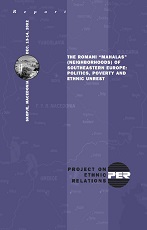The Romani "MAHALAS" (Neighborhoods) in Southeastern Europe: Politics, Poverty, and Ethnic Unrest
The Romani "MAHALAS" (Neighborhoods) in Southeastern Europe: Politics, Poverty, and Ethnic Unrest
Author(s): Andrzej Mirga, Ilia Iliev
Contributor(s): Livia Plaks (Editor)
Subject(s): Rural and urban sociology, Migration Studies, Ethnic Minorities Studies
Published by: PER Project on Ethnic Relations
Keywords: Mahala; Roma in Southeastern Europe; urban settlements of Roma;
Summary/Abstract: Large Romani “mahalas” (neighborhoods) have existed in Central and Southeastern Europe for centuries. In the post-Communist transition, these neighborhoods experienced uncontrolled growth due to the immigration of a rapidly growing and newly impoverished Romani population. They now resemble typical urban ghettos: overpopulated pockets of poverty and unemployment, dependent on welfare and unable to pay the rising costs for necessary public services.
An outbreak of ethnic violence in the Romani mahala of Plovdiv, Bulgaria, in 2002 provided a fitting background for the Skopje meeting. Indeed, PER organizers were concerned at the time that the preconditions for similar outbreaks were then existent in a number of Romani mahalas throughout Southeastern Europe. Were preventive steps not undertaken, they cautioned, similar violence could be expected. Regrettably, such concerns turned out to be well-founded as rioting was later reported in a Romani mahala in Vidin, Bulgaria in March 2003.
The report was written by Ilia Iliev of PER Sofia and by Andrzej Mirga, Chair of the PER Romani Advisory Council (PERRAC) and Chair of the Specialist Group on Roma/Gypsies of the Council of Europe. The report was edited by PER. The participants in the meeting have not had a chance to review the text, for which PER assumes full responsibility.
Series: PER Reports
- Page Count: 22
- Publication Year: 2002
- Language: English
- Content File-PDF

